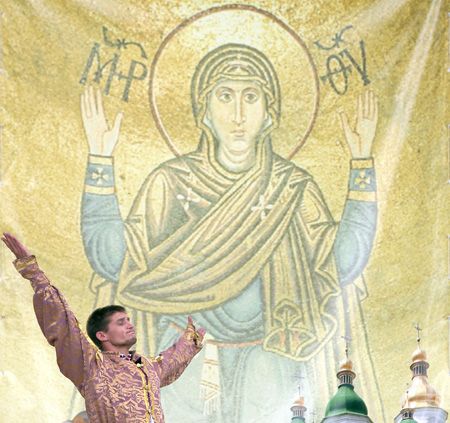Who will protect the past?
High-density developments in the central Kyiv threaten St. Sophia Cathedral and the Caves Monastery with rising water table and cracking walls. However, no funding has been made available for rescue efforts
Kyiv ought to preserve its historical and cultural heritage at all costs, UNESCO experts never tire advising Ukraine. But how can it do so under the present circumstances? Buffer zone around the two greatest shrines of the capital, St. Sophia Cathedral and the Caves Monastery, is being covered with more and more new developments, court decisions stopping them are routinely ignored, while the city’s leaders limit themselves to promises to control the situation personally. As a result, landslides, rising water table, subsiding foundations and cracking walls threaten both structures. We need to deal with the issue immediately. Leading experts from Ukraine, Russia, Kazakhstan, Ireland and other countries discussed solutions for it on November 5 at the international conference “Challenges and Experience in Engineering Protection of Urban Areas and Heritage Conservation in Geoecologically Vulnerable Areas.” Ukraine hosted a scientific gathering of this magnitude for the first time. Leadership of the two shrines places considerable hopes on the event, as it was not just a discussion of these problems, but a chance to get concrete advice on solving them from international experts. As it turned out, landmarks suffer from human activities far more than from environmental hazards.
“Water table on our site has risen to record levels, reaching the 15 meters mark,” research fellow at the National Sanctuary “Sophia of Kyiv” Nadia Movlianova related. “The causes include rain and snow, connecting new utility lines to the old ones, and developments in our buffer zone. Precipitation pushed water table by half a meter, while technical factors account for two and a half meters. A newly-built fitness center at our walls and a hotel in front of Sofiiska Square have both contributed to the rising water table, too. The water has come very close to foundation-bearing soil’s lowest layer, and, as this soil is structurally unstable, it can subside rapidly when soaked. Therefore, any structure erected on foundation-bearing soil is vulnerable, while the whole ensemble of St. Sophia Cathedral, except the bell tower, was built in the 18th century in this way and lacks special structural safeguards. These buildings cannot withstand uneven deformations, and we will have to work hard to save them.”
According to Movlianova, saving the Sophia of Kyiv requires putting an end to building underground parkings and buildings with underground floors near the cathedral. By the way, the National Academy of Sciences of Ukraine’s Institute of Geological Sciences conducted a study on the probable impact of new developments near the two shrines on their condition. The experts concluded then that such a development would cause soil to subside. For unknown reasons, no rescue programs have been instituted since. Representatives of the ministry of culture and Kyiv City State Administration, who had also been invited to the conference, explained their agencies’ inaction by pointing out that research on the issue was scarce in Ukraine, and instituting rescue programs allegedly lacked... a scientific justification.
Meanwhile, director of the National Historical and Cultural Sanctuary “The Caves Monastery of Kyiv” Liubomyr Mykhailyna was equally concerned about the future of his charge. “The monastery was built on steep slopes, making it vulnerable to erosion, landslides and surface subsidence, all these hazards affecting caves worst of all.”
The international experts recommended installing a computerized monitoring system at landmarks to enable timely response to emerging threats. “The system consists of special counters that are installed on the structure at various points from floor to ceiling. They show so-called pressure points, such as the points were cracks are likely to appear in the walls or soil to subside. The processes can be observed remotely, all displayed on a computer screen,” professor at St. Petersburg Institute of Transportation Systems Vladimir Ulitsky told us. “The system is already working on the UNESCO monuments located in Rome and the Vatican.”
However, will Ukraine find money to fund such a system? The conference participants signed a declaration, serving as a kind of plan for the future, on November 6. Still, the question who will foot the bill has remained unanswered. Rescue plans for St. Sophia Cathedral and the Caves Monastery are available already. For example, a program of engineering protection for the cathedral was developed back in 2011, but it currently lacks funding and therefore is inactive. Concerned citizens’ efforts look like the only hope.






